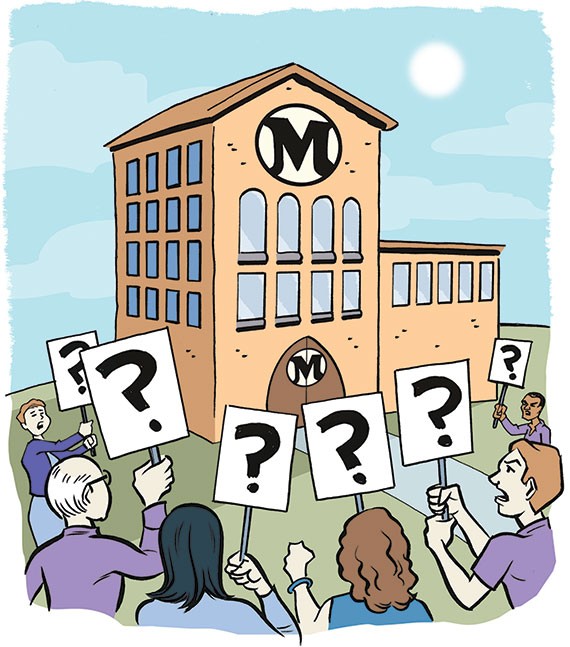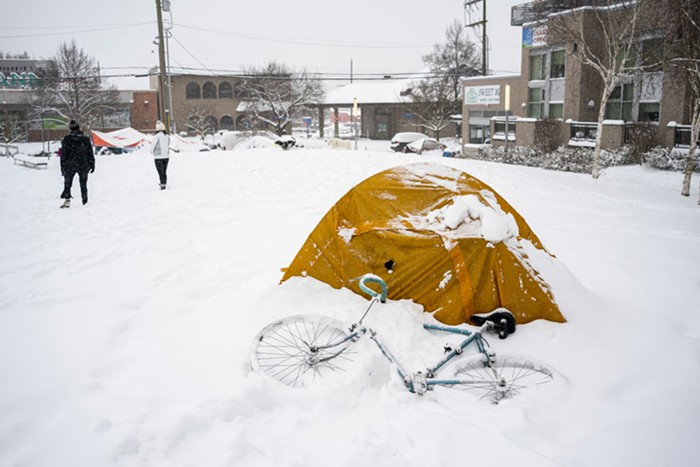
Still basking in fond memories of the snowy wonderland we got last February? The cute snow sculptures in the parks, the soft whooshing sound of flakes falling, the frosted pine trees — glorious. And also the sidewalks you slipped on, the buses that got cancelled, and the hot cocoa the store ran out of. Annoying!
Seattle looks absolutely gorgeous when it snows, but we have a tendency to be caught unprepared for God's dandruff. The forecast predicts a cold wet couple of days ahead — to say nothing of the next few months — and there’s no telling when the city will have to shut down for one big massive snowdump that could cut power, strand drivers, down trees, and generally cause beautiful frosty mayhem.
Fortunately, the city's worked out some resources and routines to keep the chaos at bay. Here’s everything you need to make sure you’re prepared for the next big snowstorm, whether it happens this year or next. The short version: Check Seattle’s Winter Storm Response center for updates regarding city services. Sign up for AlertSeattle to get notified of emergencies and shutdowns. Have plenty of supplies on hand, makes sure your boots are waterproof, and send us pics of your snow fun.
WHAT TO STOCK UP ON
The city advises that you stock up in advance with a handful of supplies: A snow shovel, a bag of street salt, warm clothes and blankets, flashlights, first aid kits, and enough food and water and medicine for three days. I also recommend having an electric blanket or hand warmer nearby — and also waterproof winter boots.
Regarding food: You will likely be grateful for easy, warm recipes; if you like to cook, I recommend a roast (of beef or a Harvest Loaf if you’re vegan) with mushroom soup. If you’re unsure about how to be in a kitchen, get a few plain frozen pizzas and a handful of toppings to throw on ahead of time. For a larger project, grab a whole-body chicken and take the opportunity to learn how to spatchcock and roast a chicken.
If you’re the custodian of a sidewalk in front of your property, you’ll need to keep ice from forming. Sprinkle some rock salt on the sidewalk ahead of time, and shovel twice a day while the snow is falling.
Every year, a handful of people try using kitty litter to de-ice the sidewalks. Do not do that, please.
STREET CLOSURES & SLEDDING WHEN IT SNOWS
Seattle doesn’t have any dedicated snowplows — when streets need clearing, the city just sticks plows on the front of whatever other trucks happen to be handy. There aren’t enough of those trucks to handle the whole city, and some streets are too steep to be plowed, so when heavy snow comes, you should be prepared for some streets to remain covered until it melts. That means you might not be able to get to the store for some time.
But it also means that some streets will become giddy slopes for sledders. (East Denny Way and Queen Anne Avenue are particularly vertiginous even when it is not snowing.) This is, it must be pointed out, illegal and carries a potential $112 fine, which means that authorities may intervene in the fun … if they are provided with a reason to do so.
If you do decide to seek out some sledding, keep your wits about you for heaven’s sake and don’t careen uncontrollably toward cross-traffic, parked cars, trees, or rocks. A local girl died of a head injury in a sledding accident back in the ‘80s, so consider bringing a helmet, particularly if you’re sledding with young people.
POWER OUTAGES
A 2014 report predicted that the city may be unable to meet peak demand for power in 2021. On top of that, wind and falling branches account for about half of local outages—it's only in the downtown area that power lines are protected underground. (Which makes them vulnerable to vault fires, which is a topic for a separate panic-piece.) If you were here in 2006, you’ll remember how parts of the city went without power for up to a week after a particularly bad outage.
Here’s how to prepare ahead of time: First, make sure you have three days of food and water on hand. Have a list of contacts outside the area so you can let people know you’re okay—or that you need help. Have a little cash on hand in case ATMs don’t work.
During an outage, don’t use generators or grills inside your home. Keep the fridge closed. And unplug electronic devices, because they could be damaged when power comes back on.
And if you have medicine that needs refrigeration, or medical equipment that needs power, check with a medical provider to make sure your care isn’t interrupted. Check the city’s Lifeline program, which works with people whose health may be impacted by power interruptions.
HOUSING
It’s easy to offer advice like “make sure you have enough blankets,” but over ten thousand people in King County (and that's definitely an undercount) don’t even have permanent stable shelter. A few years ago, a man with no fixed address died at the Sodo light rail station during cold weather, and this year the pandemic makes it even harder to secure safe shelter.
Several resources may be able to help if you’re outside during dangerously cold temperatures. Urban Rest Stop can provide warm showers, laundry, and restrooms, and Solid Ground provides transportation downtown. You can find a directory of shelters here, and also by calling 211.
The city is opening two winter-weather shelters this weekend — down from three last year, and only open at night. There's also a privately-run emergency shelter in West Seattle.
LANDSLIDES — YES, REALLY
The Seattle area experienced a series of damaging landslides in 1996 and 1997, including one that killed a family on Bainbridge Island. A little more than 8% of the city has been identified as slide-prone, about a third of which is designated as single-family residential, and they can occur without warning, particularly after rapid snowmelt.
Fortunately, there’s an online tool that monitors and reports on Seattle’s landslide risk—updated once per hour, the graphs indicate the relative risk of landslide based on a variety of factors. If you live along Seattle’s northwest or northeast slopes, you should be particularly attentive to risk, because landslides have been increasing in those areas according to the city. Areas of recent landslide activity include Southwest Magnolia, Northwest and Southwest Queen Anne, East Queen Anne, Alki, Admiral Way, West Beacon Hill, Interlaken, Madrona, and Pigeon Point.
DRIVING
Here’s how to drive safely when it snows: Don’t.
Just stay off the road. Really. Even under the best of conditions, there’s no such thing as a crash-proof car; but when there’s ice and reduced visibility, you’re heading into significantly heightened danger.
If you absolutely must drive, slow down. Check the WSDOT’s recommendations for traction tires and chains—certain roads will be restricted unless you have them on your car. Check for pass closures here.
And make sure your car is well-stocked with supplies: A flashlight, batteries, a blanket, snacks, gloves, boots, first aid, spare cellphone battery, jumper cables, flares, sand, and a whistle. In 1991, an elderly couple got stuck in the snow in California and left a diary of their slow deaths over several days and I have never been able to get the story out of my mind.
HAVE FUN
Okay that was a huge bummer, I'm sorry. Snow is also beautiful and fun and really nice! When the next blizzard comes—if the next blizzard comes, considering that climate change may make snow a thing of the past—you should also be ready to go out and enjoy it, for crying out loud. Get yourself some nice cold-weather clothes and waterproof boots and go for a walk. I personally like the Arboretum and Volunteer Park when it's snowy—the view from the tower is quite lovely if it's open—and Queen Anne is good for a hike if you want your legs to truly ache.
Just remember to watch out for ice.
SO MUCH FOR GLOBAL WARMING
Oh and one more thing: If you have the misfortune to encounter someone who thinks that a snowstorm disproves the existence of climate change, the polite thing to do is to grab them by the lapels, shake them violently, and scream as loud as you can into their face, “CLIMATE!!! IS DIFFERENT!!! FROM WEATHER!!!!!!”
Then you can go back to remarking on how it's really coming down out there.













